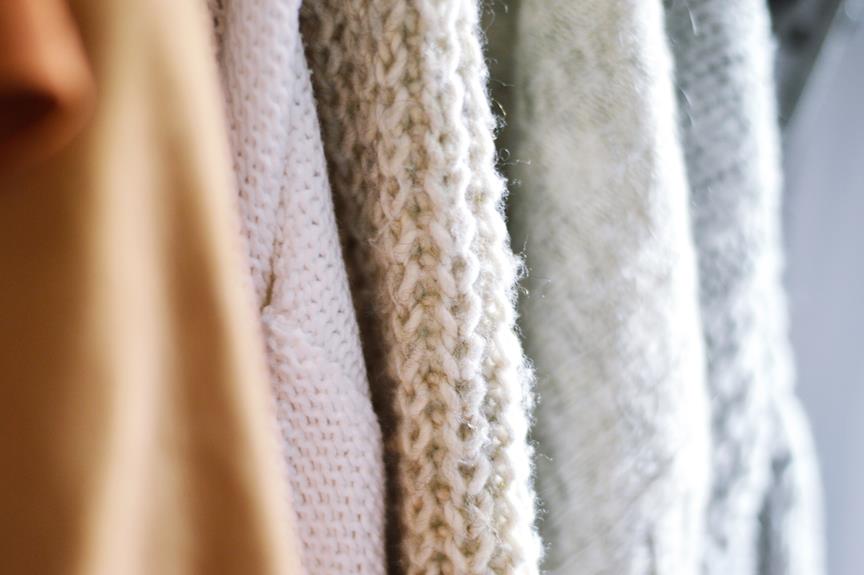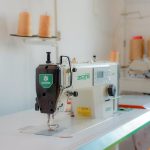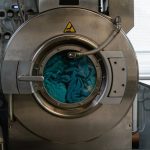Are you ready to master the art of knitting different fabrics with precision?
Understanding which knitting machines are best for different fabrics is crucial for achieving professional-quality results.
With a wide array of fabrics available, it's fascinating to note that each fabric requires a specific type of knitting machine for optimal results.
From fine silks to heavy-duty denim, knowing which knitting machines to use can make all the difference in your crafting projects.
In this guide, we'll explore the best knitting machines for various fabrics, providing you with the knowledge you need to excel in your knitting endeavors.
Key Takeaways
- Specialized knitting machines are available for different fabrics, such as fine silks and lightweight cotton, and it is important to consider the ideal gauge and machine tension for each fabric.
- Circular knitting machines with adjustable tension settings are suitable for spandex and elastic fabrics, allowing for control over fabric stretch and elasticity. Multiple feeders on these machines also allow for versatile fabric designs.
- Knitting machines for specialty fabrics, such as lace, velvet, and terry cloth, require specific features and capabilities. Fine gauge machines are ideal for delicate lace fabrics, while loop and cut pile capabilities are necessary for velvet fabrics. Loop production and variable yarn tension are important for terry cloth.
- Tips and techniques for knitting machines include adjusting tension settings, selecting the right needles for smooth stitching, maintaining machines for optimal performance, and incorporating different yarns to achieve desired elasticity and recovery in stretchy knits.
Knitting Machines for Fine Silks
You can achieve exquisite results when knitting fine silks using specialized machines designed for delicate fabrics. These machines are designed to handle the unique characteristics of silk yarn, ensuring a smooth and even knit without causing any damage to the delicate fibers. When working with complex lace designs, it's crucial to use a knitting machine that can handle the intricate patterns and maintain the integrity of the fine silk yarn.
Silk yarn compatibility is a key consideration when choosing a knitting machine for fine silks. Look for machines that offer adjustable tension settings to accommodate the delicate nature of silk yarn. Additionally, a machine with fine gauge needles will ensure that the silk yarn is handled gently and with precision, resulting in beautifully knitted fabric.
When working on complex lace designs with fine silk yarn, it's essential to select a knitting machine that can handle intricate patterns with ease. Machines equipped with punch card or electronic pattern systems allow for the creation of elaborate lace designs, adding a touch of sophistication to your silk knits.
Knitting Machines for Lightweight Cotton
When working with lightweight cotton, it's important to consider the ideal gauge for the fabric. This will ensure that the stitches are even and the fabric has the desired drape.
To achieve the ideal gauge, you may need to make necessary machine tension adjustments. Lightweight cotton tends to require a looser tension to avoid creating a stiff fabric.
In addition to adjusting the machine tension, it's crucial to select the right needles for knitting with lightweight cotton. Using needles that are too small can result in tight, dense stitches, while using needles that are too large can create a loose, sloppy fabric.
Ideal Gauge for Cotton
Selecting the right gauge for lightweight cotton fabric on knitting machines is crucial for achieving the desired texture and drape. For lightweight cotton, a finer cotton gauge is typically ideal.
When working with cotton, using a smaller gauge like 5 to 7 is recommended to achieve a tighter stitch, which is essential for creating a fabric with good drape.
Additionally, employing suitable knitting techniques, such as adjusting the cotton stitch size and tension control, is crucial for achieving a smooth and even fabric texture.
Be mindful of the tension settings on your knitting machine when working with lightweight cotton to ensure that the stitches are neither too loose nor too tight.
Machine Tension Adjustments
Achieving the ideal tension on your knitting machine is essential for creating high-quality lightweight cotton fabrics, especially when aiming for a smooth and even texture. When working with lightweight cotton, proper tension control is crucial. Here's how to ensure your machine is adjusted for the best results:
- Tension Control: Understand how to manipulate the tension dials on your machine to achieve the right balance for lightweight cotton.
- Adjust the tension settings gradually, making small changes and testing the fabric frequently.
- Pay attention to the fabric as it knits, looking for any signs of too much or too little tension.
- Troubleshooting: Learn common tension issues and how to troubleshoot them effectively.
Needle Selection Tips
To knit lightweight cotton fabrics effectively on your knitting machine, selecting the right needles is crucial for achieving the desired texture and drape. When it comes to needle selection for lightweight cotton yarn, it's important to consider the yarn's compatibility with the needles to ensure smooth and even stitching. Choosing the correct needle type and size can make a significant difference in the outcome of your fabric. Here's a helpful guide to needle selection for lightweight cotton fabrics:
| Needle Type | Recommended Size |
|---|---|
| Standard (L) | 6-8 |
| Mid-Gauge (M) | 6-7 |
| Bulky (B) | 5-7 |
| Fine (F) | 5-6 |
Knitting Machines for Medium-weight Wool
For medium-weight wool, you'll want to use a knitting machine that can handle the thickness and elasticity of the yarn. When working with medium-weight wool, there are a few key considerations and adjustments you should make to ensure the best results:
- Yarn Weight Considerations and Tension Adjustments
- Use a knitting machine suitable for medium-weight yarn, typically a standard gauge machine with a needle pitch of 4.5mm to 5mm.
- Adjust the machine's tension settings to accommodate the specific thickness and elasticity of the medium-weight wool yarn, ensuring even and balanced stitches.
- Fabric Density and Needle Selection
- Aim for a balanced fabric density that isn't too loose or too tight, which can be achieved by adjusting the machine's stitch size and carriage settings.
- Select appropriate machine needles based on the yarn thickness and desired fabric density, ensuring that the needles are compatible with the chosen knitting machine.
Choosing the right knitting machine and making these adjustments will help you achieve high-quality, medium-weight wool fabrics with excellent drape and warmth.
Knitting Machines for Heavy-duty Denim
When working with heavy-duty denim, you'll want to choose a knitting machine that can handle the durability and thickness of the fabric. Denim knitting machines are specifically designed to handle the heavy-duty nature of denim, providing the necessary strength and durability to work with this fabric. These machines typically have sturdier needles and a more robust framework to withstand the demands of heavy-duty denim knitting.
When using a knitting machine for heavy-duty denim, it's essential to employ specific heavy-duty fabric knitting techniques. This includes using thicker yarns and adjusting the machine's settings to accommodate the density of the denim. Additionally, ensuring that the machine is equipped with the appropriate needle types and gauges can make a significant difference in the quality and efficiency of denim knitting.
When selecting a knitting machine for heavy-duty denim, consider models that offer adjustable settings, such as stitch size and tension, to accommodate the unique characteristics of denim. Look for machines with a strong motor and sturdy construction to effectively handle the demands of heavy-duty denim knitting.
Knitting Machines for Stretchy Knits
Looking to create stretchy knits like spandex or other elastic fabrics? You'll want to consider the best knitting machines for these materials. The right machine can make a huge difference in the quality and elasticity of your knits, so it's important to understand the factors to consider.
Let's explore the ideal knitting machines for stretchy knits and the key considerations to keep in mind.
Best Machine for Spandex
When considering knitting machines for stretchy knits like spandex, prioritizing one with adjustable tension settings is crucial for achieving the desired stretch and recovery in the fabric.
Here are some key points to consider when choosing the best machine for spandex:
- Spandex machine options:
- Look for a circular knitting machine with a cylinder and dial arrangement, as this type of machine can efficiently knit spandex into various garment types with the required stretch.
- Consider a machine with multiple feeders to easily incorporate spandex along with other yarns, allowing for versatile fabric designs.
- Spandex fabric considerations:
- Ensure the machine has the capability to create a balanced fabric structure, maintaining the elasticity of spandex while preventing overstretching during the knitting process.
Ideal for Elastic Fabrics
To knit elastic fabrics like spandex effectively, you'll need a knitting machine that offers adjustable tension settings and multiple feeders for incorporating various yarns.
When considering elastic fabric machine options, look for models specifically designed for stretchy knits, as they often come with features tailored to handle the unique properties of these fabrics.
Additionally, regular maintenance of your knitting machine is essential for optimal performance when working with elastic fabrics. Keep the machine clean and well-lubricated to prevent any issues that could affect the quality of your knits.
When troubleshooting stretchy knits, pay close attention to the tension settings and make adjustments as needed to achieve the desired elasticity and recovery in the fabric.
Stretchy Knit Considerations
For knitting elastic fabrics like spandex, you'll need a knitting machine that offers adjustable tension settings and multiple feeders for incorporating various yarns, specifically designed to handle the unique properties of these fabrics.
When considering knitting machines for stretchy knits, focus on the following factors:
- Elasticity Control: Look for a machine that allows precise control over the amount of stretch in the fabric, ensuring it meets the specific requirements of the project.
- Adjustable Tension Settings: Machines with adjustable tension dials or settings enable you to fine-tune the stretchiness of the knit, accommodating different types of elastic yarns.
- Multiple Feeders: Having multiple feeders on the knitting machine allows for the incorporation of different yarns with varying levels of elasticity, enhancing the versatility when working with stretchy knits.
Knitting Machines for Specialty Fabrics
How can you utilize knitting machines to create specialty fabrics such as lace, velvet, and terry cloth? Knitting machines offer a versatile way to produce specialty fabrics, allowing you to experiment with different textures, patterns, and materials. When it comes to creating specialty fabrics, knitting machines equipped with specific features and capabilities are essential. For instance, to produce delicate lace fabrics, a fine gauge knitting machine with intricate patterning capabilities is ideal. On the other hand, for velvet fabrics, a machine with the ability to create loop piles and cut piles is necessary. Additionally, when working with terry cloth, a machine with the capability to produce loops and incorporate varying yarn tensions is beneficial. Here's a table to further illustrate the knitting machine options for different specialty fabrics:
| Specialty Fabric | Recommended Knitting Machine Features |
|---|---|
| Lace | Fine gauge, intricate patterning |
| Velvet | Loop and cut pile capabilities |
| Terry Cloth | Loop production, variable yarn tension |
Frequently Asked Questions
Can Knitting Machines Be Used to Create Intricate Lace Patterns on Fine Silks?
Yes, you can create intricate lace patterns on fine silks using silk knitting machines. These machines are designed to work with delicate fabrics and produce beautiful, detailed designs. Lightweight cotton knitting machines are also great for delicate cotton fabrics.
Are There Any Specific Knitting Machine Brands or Models That Are Best for Creating Delicate, Lightweight Cotton Fabrics?
When creating delicate, lightweight cotton fabrics, consider knitting machine brands with fine gauge options. These machines excel at intricate lace patterns on fine silks and can also handle medium weight wool, heavy-duty denim, spandex blends, and ribbed knits.
How Does the Gauge of a Knitting Machine Impact Its Ability to Work With Medium-Weight Wool?
When working with medium-weight wool on a knitting machine, adjusting tension is crucial. This impacts the gauge and ensures yarn compatibility. You'll need to find the right balance to achieve the desired fabric quality.
Are There Any Special Considerations or Techniques for Using Knitting Machines to Work With Heavy-Duty Denim?
When working with heavy-duty denim, there are special techniques and machine considerations for knitting. You'll need a machine with a strong motor and sturdy needles to handle the thickness of denim fabric.
Can Knitting Machines Accommodate the Unique Stretch and Elasticity of Certain Knit Fabrics, Such as Spandex Blends or Ribbed Knits?
Yes, knitting machines can handle the unique stretch of spandex blends and ribbed knits. They are capable of creating intricate lace patterns and adjusting tension to accommodate different fabric types.
- How Does Ring Spun Cotton Affect Garment Fit and Shape Retention? - August 13, 2024
- What Are the Challenges in Producing Ring Spun Cotton? - August 13, 2024
- Is Ring Spun Cotton Suitable for Plus-Size Clothing? - August 13, 2024






